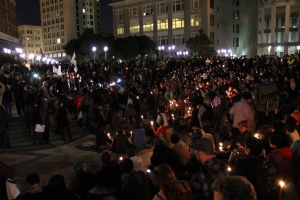Scott Olsen, a marine who served two tours in Iraq, had been active in Occupy San Francisco and was with us in the streets of Oakland Tuesday night. When police started shooting into the crowd, a projectile hit Scott, fracturing his skull and putting him in critical condition. Rather than offering help, police actually fired right into the small crowd that was trying to help get the near-unconscious Scott out of the cloud of tear-gas.
This video does a great job showing what happened.
Tonight, Occupy Oakland honored Scott’s courage by holding a candlelight vigil. As you can see in this video I took, thousands gathered again, showing the world that this movement is not letting up.
Please watch the video, it was a powerful evening. The speakers spoke with passion and compassion and were all incredibly moving and eloquent. One of the great things about this movement is that it has given a platform to regular people – not professional activists, not elected officials, just everyday people. We sometimes think that someone needs to be a “known” figure for them to inspire us with public speeches.
Thanks to Scott, we were reminded that change comes from everyday people, not the “leaders” we sometimes look up to. Thanks to Scott, the people were reminded what we are all fighting for. Thanks to Scott, we awoke the moral conscience of Oaklanders and of people all over the world.
To support Scott and help pay for his medical expenses, please visit the website of Iraq Veterans Against the War at www.ivaw.org.
Please keep Scott in your thoughts and prayers as he faces a long recovery.
And now onto more random thoughts….
I Hella Love Occupy Oakland
I continue to be amazed and inspired by the Occupy Oakland movement.
When Occupy Oakland first started, there were hundreds of tents set up immediately, and the plaza was transformed overnight. Within days, they were feeding hundreds of people every day, had set up a library, school, media tent, bicycle powered generators, constant free music performances, workshops, speakers, free child care. As I wrote earlier, we may not have been articulating our demands on paper, but we were manifesting our vision in the middle of the city.
Then, at 5AM on Tuesday, the police raided the camp. In coordination with 17 different law enforcement agencies, they woke up kids sleeping in tents. They shot tear-gas into the encampment. They arrested almost 100 campers.
They tore down tents, the library, medical tent, arts and crafts tent, everything. By the time people were leaving to go to work, they had left the plaza a mess and blocked off the entire park.
Just hours later at 4PM – with no prior planning before that morning – people gathered at the public library. Lots of people. The police reportedly called the library and asked them to not allow us to gather there. They refused. As a public institution serving the community that keeps facing budget cutbacks, they realize which side they were on.
The crowd filled the library steps and spilled out taking up the entire street. As we began marching, we would come up to a police line, and start marching in another direction. No one knew where we were going, and decisions about which direction to head were made on the spot. Yes, it was confusing and at times frustrating, but it also made it impossible to keep us contained. We marched around the entire city for hours.
Typically, you would see the numbers of a march like this dwindle after a while. That was not the case. As we marched around the city, we picked up people along the way. The “direction-less” nature of the march only made us more visible and increased our numbers. By the time it was dark we were 1,000 strong. After a short impromptu Assembly at Snow Park, we marched back to Oscar Grant/Frank Ogawa Plaza. And there we ran into the police.
As I wrote about and as you can see in this video I took, the police’s response was viscous. They shot tear-gas into a peaceful crowd, critically injuring a veteran who served two tours in Iraq. Scott Olsen sustained a fractures skull, and as others were trying to help remove him from the cloud of tear-gas, the police fired again right into the middle of the crowd that was trying to help him.
Despite the violence perpetrated by the police, the protesters for the most part remained nonviolent. And THAT was the key.
The Public Narrative & Lessons from Selma
In 1965, 600 marchers walked across the Edmund Pettis Bridge in Selma, Alabama and were attacked by the police. They were beaten and attacked by dogs. And the marchers remained nonviolent. When images of police attacking nonviolent protesters go out, it paints a very clear image of who is on the right side of justice. It wins the sympathy and the support of the larger public.
Two days after what became known as “Bloody Sunday,” 2,500 marchers gathered in Selma. And a week later, 8,000 marchers began the long walk to Montgomery, a movement that culminated in the passing of the Civil Rights Act.
Oakland has learned from the Oscar Grant rallies. During those events, violence often broke out and police and protesters engaged in it. There was looting and cars were destroyed. And the public narrative that went out into the news was “police fight back violent rioters.” The images were of youth jumping on top of police cars and clashing with cops.
This time, the narrative was very different. This time, the public narrative was “police attack peaceful protesters.” The images that went out were of protesters trying to run away from a cloud of tear-gas.






